
The fungus Phytophthora infestans has become a real misfortune for gardeners growing tomatoes in a greenhouse. The outbreaks of late blight that it causes are compared with the flu epidemic. In a few days you can lose the whole crop of tomatoes. The industry produces drugs for the fight against fungus, but popular remedies for the control of late blight in the greenhouse remain in use.
Content
Symptoms of late blight
Brown spots on the first tier of leaves are the beginning of the disease. The rate of development of the disease depends on the microclimate of the greenhouse (humidity, soil and air temperature). At the initial stage, the size of the spots is small, localization is absent. The reverse side of the leaves, in addition to spots, can be covered with a white fluffy coating.
Within a few days, the spots quickly increase in size, turn brown, the leaves affected by the fungus dry out and fall off. The disease continues to develop, affects the stem, black spots appear on it. The line reaches the fruits. They can become covered with brown spots while on the bush, or darken later during storage during ripening.
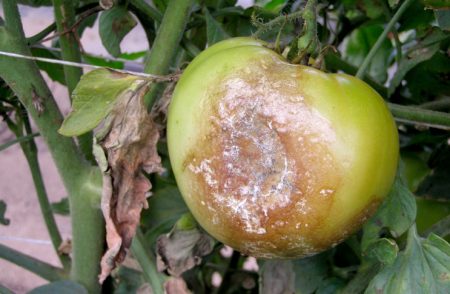
The fungus affects all the aerial parts of the tomato bush:
- inflorescences;
- leaves;
- stalks;
- fruit;
- stem.
Eating fruits infected with the fungus can be dangerous due to spores that have penetrated the flesh. Tomatoes can have an unpleasant aftertaste that will ruin the taste of any dish.
Reasons for the appearance
Changeable summer weather is the main cause of late blight on outdoor tomatoes and in greenhouses. The spores of the fungus easily move through the air and from the plantation of infected potatoes can penetrate the greenhouse. Night cooling, excessive soil and air humidity in the greenhouse are the main causes of late blight.
Greenhouses that are not equipped with an automatic ventilation system can be condensed with large differences in daily temperatures and in rainy weather. For a fungus, such dampness creates favorable conditions for reproduction.
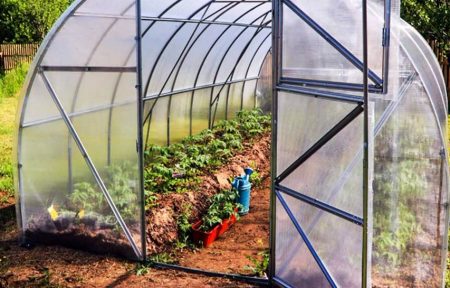
High humidity may be the result of a dense planting of bushes, untimely removal of stepsons and leaves. Thickly planted tomatoes do not receive the necessary amount of sunlight, their immunity suffers from this, they are more susceptible to fungal diseases.
Reduces immunity and unbalanced in the content of nitrogen, phosphorus and potassium top dressing. Excess nitrogen in the soil weakens the tomatoes in the greenhouse, making them more susceptible to any infections. Spores of Phytophthora infestans winter in the soil, outbreaks of late blight can not be avoided if at the end of the summer season the greenhouse soil is not treated from fungus.
Chemistry against late blight
When the first symptoms of late blight appear, chemical preparations are used. For efficiency, tomatoes in a greenhouse are treated with various means during the season. This eliminates the moment of getting used phytophthora to the active substance.
Many gardeners traditionally use copper sulfate from late blight. Preparation of the working solution does not take much time. In a bucket of water dissolve 2 tbsp. l funds and start processing the bushes.

Sulphate can be used before flowering tomato, if late blight struck tomatoes at the fruiting stage, then other drugs should be used.
Systemic drugs
In the initial stage of the disease (spots on the leaves), the tomatoes are treated in the greenhouse with the Quadris or Previkur preparations. If the disease affects the leaves and stems, the remedy goes:
- Bravo;
- Cuproxate;
- Infinito.
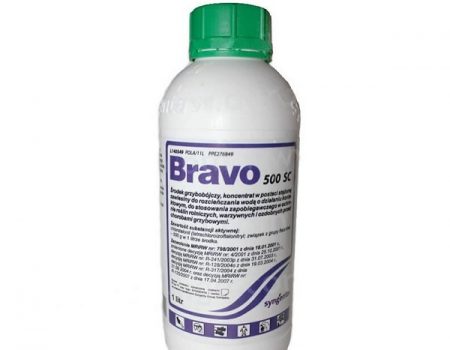
Separately, it is worth noting the drug Consento, it protects tomato bushes from late blight and alternariosis.
Biological products
Biological preparations are less dangerous for ecology. Unlike chemicals, their effect is less aggressive. The mechanism of action is the selection of microorganisms that destroy the fungus Phytophthora infestans. Beneficial microorganisms are activated when they come into contact with water when preparing the working fluid.
Fitosporin-M deservedly occupies the first most popular place in the control and prevention of late blight. It does not make sense to use it at the height of the epidemic; it is effective as a preventative measure (treatment of seeds, soil, seedlings) and when the first symptoms appear.
A concentrated solution prepared from 200 g of paste and 400 ml of water without chlorine at room temperature is stored for unlimited time, methods of its use:
- 4 drops of concentrate are dissolved in a glass of water, a liquid is obtained for soaking the seeds before planting;
- to soak the roots of seedlings before transplanting into 5 l of water add 15 drops of concentrated funds;
- 2 tbsp. l Fitosporin solution;
- a solution for spraying bushes is prepared from 10 l of water and 3 tsp of concentrate.
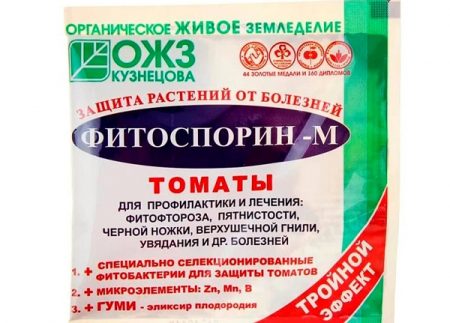
To protect tomatoes in the greenhouse from late blight, the treatment of bushes is carried out every 2 weeks.
Summer residents who use Fitosporin-M for the prevention of late blight, note good immunity and stress resistance of tomatoes.
Biological products received good recommendations from gardeners:
- Baktofit;
- Phytophtorin;
- Planriz.
These funds are used in the initial period of the growing season for the prevention of fungal diseases.
Simple folk recipes for protection against fungus
Plus folk recipes - their complete safety for our health. Fruits immediately after processing can be safely consumed.
Garlic infusion
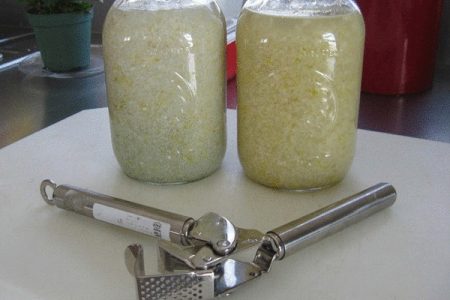
One bucket of infusion is enough for 20 bushes of tomato, spend 0.5 liters per bush. For cooking, you need ½ tsp. potassium permanganate and 1½ Art. cloves of garlic. The teeth need to be chopped, mixed with potassium permanganate, pour 2 liters of water.
The container can be taken glass or plastic, it should be with a lid. Infuse garlic for about 30 minutes. The obtained tincture before use is required to strain, dilute 10 liters of water, water the bushes under the root.
Copper wire
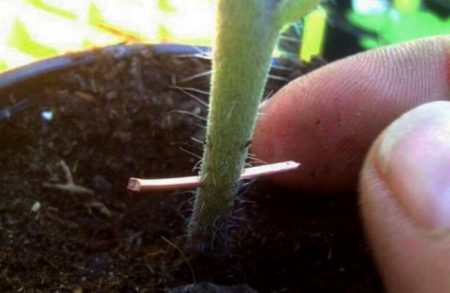
The gardener needs to have a copper wire on hand. With its help, you can protect the tomato bushes from late blight. There are two options:
- wrap the stem at the bottom with several turns of thin copper wire;
- cut a piece (4 cm) of wire and stick into the base of the stem, bend the tips to the ground.
These methods can be used only on adult bushes with a thick stem.
Milk and Dairy Products
Lactic acid bacteria contained in kefir, whey, milk successfully fight the fungus by spraying tomatoes. Milk consumption 100 ml per liter of water, whey is diluted in a ratio of 1: 1. To enhance the effect, it is recommended to drop a couple of drops of iodine into the milk solution.
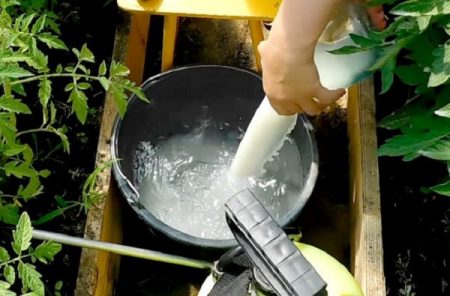
It is better to spray tomatoes after 19-00, at sunset. Every 2 weeks, the treatment will have to be repeated. Milk and iodine are a good prevention of fungal diseases. Healthy bushes are sprayed to prevent phytophthora outbreaks. The first treatment is carried out 2 weeks after transplanting the seedlings into the greenhouse.
Pharmacy products
On the pharmacy shelf, you can find medicines that treat not only human diseases, but also save greenhouse tomatoes from infection:
- Trichopol - A broad-spectrum antibiotic that copes with late blight and does not harm the plant itself.2 tablets of Trichopolum are dissolved in 1 liter of water and the bushes are sprayed in the greenhouse every 10 days.
- Furatsilin apply 3 times per season. The first treatment is during flowering, the second is at the stage of ovary formation, the third is at the end of summer. For a liter of water, 1 tablet of furatsilin is needed.
- Calcium chloride use once during an epidemic, the development of the disease stops, the fruits do not deteriorate. The product is sold in the form of a 10% solution. In 2 l of water, take a 1 200 ml bottle and prepare a 1% working solution.
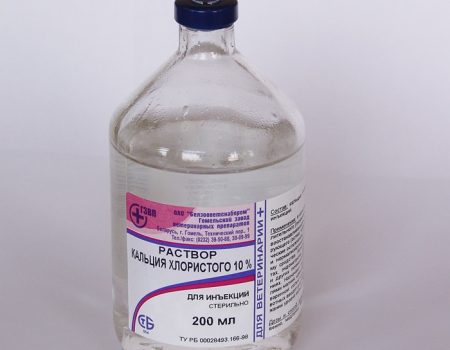
Harvesting and storage
Externally healthy green tomatoes without brown spots may remain on diseased bushes. They need to be collected and lowered for 15 seconds in warm water (60 ° C). Before sending the fruits to ripen, they are thoroughly wiped.
Save the tomato crop with the help of blanks. Both red and green fruits can be used. When heat treated, spores of the fungus die. There are blanks from fruits ripped from diseased bushes, not dangerous.
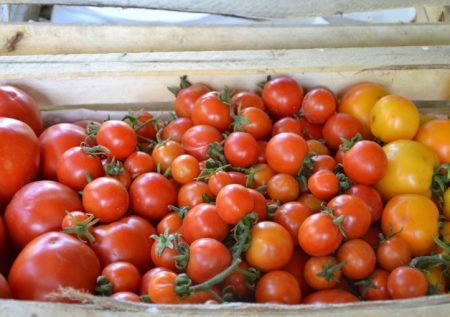
Prevention
It is not easy to save a dying crop. Experienced gardeners prefer to protect their plantings from phytophthora to the maximum with the help of simple preventive measures:
- choose varieties (hybrids) with increased resistance to late blight;
- disinfect soil for seedlings;
- process seeds;
- feeding seedlings and adult plants during the growing season;
- in the fall and spring, they prepare the greenhouse for the new season;
- control the level of humidity and temperature in the greenhouse;
- compliance with the recommended landing pattern;
- the use of drip irrigation and mulch.
Grade selection
Phytophthora begins to rage in greenhouses when the summer heat is declining, it is still hot during the day, and it gets colder at night or during prolonged rains. Finding the perfect variety 100% resistant to fungus will not work. The problem is solved by the choice of ultra-early and early varieties ripening before the fungal epidemic.
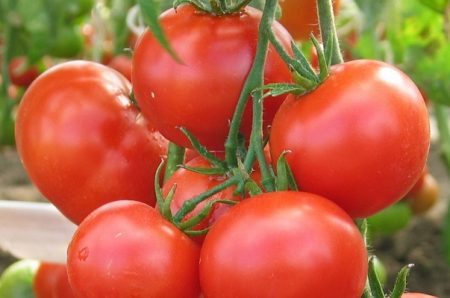
Tomatoes showed good stability:
- Budenovka. Large-fruited (300 g), mid-ripening (100-110 days) variety with indeterminate type bushes (height 1.5-1.7 m), yield about 20 kg / m² with a planting scheme of 3 bushes per 1 m².
- Eupator F1. Hybrid with indeterminate type bushes (1.8 m high), mid-season, medium-sized fruits (100-150 g), red, yield up to 4.5 kg from 1 bush.
- La La La F1. A hybrid with determinate type bushes (height 1.5 m), mid-ripening (110-115 days), medium-sized fruits (120-150 g), red with a glossy skin and excellent taste, up to 3 kg of fruits are removed from 1 bush.
- Andromeda F1. Early hybrid (90-115 days), bushes 0.7 m high, red, pink, yellow fruits weighing 75 to 125 g, yield 6 to 10 kg / m².
Seed and soil treatment
The soil, even purchased, must be treated 1-2 weeks before sowing seeds for seedlings:
- warm up for 30 minutes at a temperature of 90 ° C;
- shed with potassium permanganate;
- shed with garlic infusion;
- treated with a solution of phytosporin.
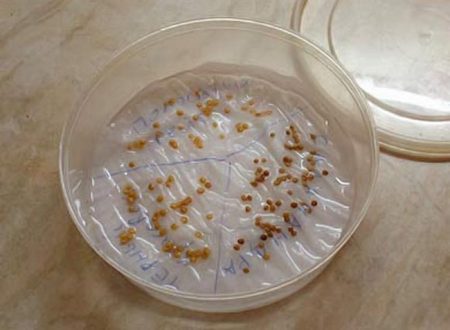
Purchased seedlings before planting must be treated with fungicide.
Tomato seeds are first calibrated, then pickled using solutions of potassium permanganate or Fitosporin. Their seeds collected from bushes affected by late blight are subjected to heat treatment - they are heated for at least 2 hours at a temperature of 50 ° C.
Greenhouse care
The spores of Phytophthora infestans for many years maintain vital activity in the land and plant debris, therefore, at the end of each season, a greenhouse needs to be cleaned:
- remove plant debris and mating;
- wash glass (polycarbonate) with laundry soap;
- clean supporting structures from dust and dirt, treat wooden parts with a solution of lime and copper sulphate.
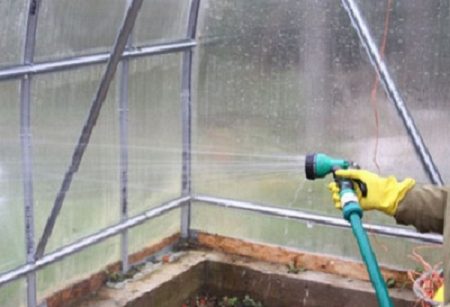
About once every 3-4 years, remove the top soil layer with a thickness of 5 to 7 cm, take it to a compost pile for resuscitation. At the same time, replenish the fertility of greenhouse soil by making:
- peat;
- humus;
- compost;
- sand.
To process greenhouse soil with Carbation; the air temperature during processing should be positive (18 ° C).The drug is toxic; personal protective equipment is needed when working with it. Its use is justified if the greenhouse is infected with late blight.
Care Rules
Protecting tomatoes from sheltered soil from phytophthora is much easier than growing in open ground. In a greenhouse equipped with window leaves, it is easy to control the microclimate (temperature, humidity). In addition, the gardener must follow the rules for caring for tomatoes in the greenhouse:
- comply with the recommended landing pattern;
- to form bushes, removing excess stepchildren;
- use supports for garter bushes;
- mulch the bed with dry grass, peat, a black film.
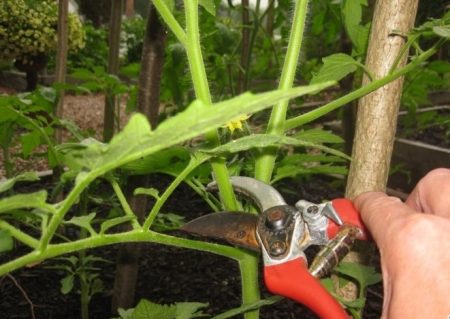
Do not plant vegetables from the nightshade family near greenhouses with tomatoes: potatoes, peppers, eggplant.
Disputes enter the greenhouse through doors with a stream of air. The source of infection can be vegetables growing in the open ground: potatoes, eggplant, pepper.
Reviews
Elena, Nikolaev
I subtracted a recipe with pine shoots from phytophthora in an old magazine about a garden garden, she processed bushes about 4 times during the summer, there were practically no phytophthora. The broth was prepared from freshly picked pine shoots. First they held them for 10 days in the refrigerator in the vegetable compartment, then chopped them finely. On 1 tbsp. chopped shoots added 2 tbsp. water, brought to a boil and boiled for very 3 minutes on a very low fire. The broth cooled, added 5 tbsp. water and sprayed bushes in the greenhouse. The first time I processed tomatoes 2 weeks after transplanting, I did the remaining 3 sprays about 1 time in 3 weeks.
Sergey, Magnitogorsk
There is experience in the successful fight against late blight of tomatoes in a greenhouse. The weather was damp and the first signs of late blight appeared on the bushes. They didn’t hesitate and almost immediately treated with a solution of iodine and salt, and literally the next day Fitosporin, at the same time they stopped watering, pulled out weeds, the leaves damaged by infection were torn off. The last tomatoes were removed in early September, late blight was able to calm down.
Tatyana, Moscow Region
I process the trunks of diseased tomatoes with gruel prepared from water, chalk and potassium permanganate. I apply with a small brush, remove diseased leaves. The method is simple, but effective, with its help I always manage to stop the development of late blight.




 Low-growing tomatoes, without pinching: 5 of the most delicious varieties
Low-growing tomatoes, without pinching: 5 of the most delicious varieties Why tomato seedlings grow poorly
Why tomato seedlings grow poorly We grow a tomato in a shell
We grow a tomato in a shell Growing tomatoes without watering according to the method of Kazarin
Growing tomatoes without watering according to the method of Kazarin